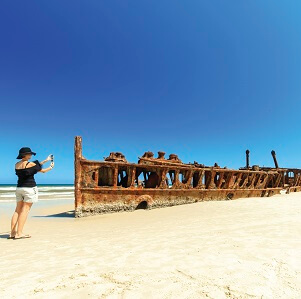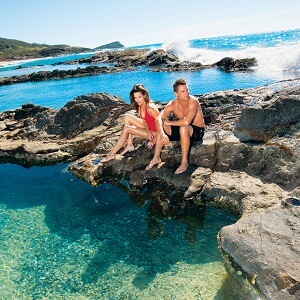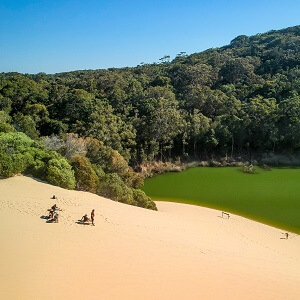Fraser Island Tours are set to reopen from mid-June. If you can’t visit yet in person, or just want a taste of what you can expect, our virtual tour explores our favourite island spots via the computer screen.
- Fraser Island Tours are set to reopen from mid-June. If you can’t visit yet in person, or just want a taste of what you can expect, our virtual tour explores our favourite island spots via the computer screen.
- 75 mile beach
- Eli Creek
- Maheno Shipwreck
- Rainforest
- Lake McKenzie
- Explore Our Fraser Island Tours!
Just a short ferry trip off the coast of Queensland sits Fraser Island, the largest sandy island in the world and an extraordinary spot for nature lovers. 123 kilometres long and 22 kilometres wide, the long thin island is host to an astonishing variety of environments, from subtropical rainforest, to eucalyptus woodland and mangrove forests. Snaking across the island are several freshwater creeks and lakes, while the coast is lined with phenomenal sandy white beaches. Combine all these natural attractions with the local wildlife spotting opportunities and its no wonder Fraser Island is such popular destination for travellers.
The Butchulla people have called the island home for at least 5000 years and is known as K’gari in the local language. It was christened Great Sandy Island by European explorers, but the name was later changed to Fraser Island after Eliza Fraser, who was marooned on the island for six weeks in 1836. She survived living with the Aboriginal inhabitants, before being rescued by a convict living in the area.
Fraser Island is now home to less than 200 permanent human residents, and roughly the same number of dingoes. The island’s mild weather, proximity to Brisbane and, of course, spectacular natural scenery, make it a popular destination for both local and international travellers. So climb aboard our virtual 4WD as we explore this stunning region.
-
75 mile beach
It’s not hard to imagine how this beach got its name – unsurprisingly it’s a beach that’s 75 miles long. The sandy highway runs much of the eastern length of the island and is a popular road for 4WD cruising. While driving on the beach might feel like a thrilling lawless activity, it is still subject to regular road regulations including an 80-kilometre speed limit.
There are also a few other unique conditions to be aware of while driving along this picturesque highway. First, it’s also a landing strip for scenic flights, so you may need to give way to aeroplanes coming to land. Keep an eye out for the local dingoes that patrol the coast, and hidden sandy bumps and dips on the road. Perhaps most importantly, check the tide times before you start your journey because watching your 4WD be slowly consumed by the ocean is no one’s idea of a holiday. Finally, no matter how appealing the refreshing azure waters seem, 75 mile beach is not good for swimming. The ocean currents are too strong and if that doesn’t put you off, the population of sharks in the area definitely will.
-
Eli Creek
One of the largest rivers of the island is Eli Creek, a shallow freshwater waterway that flows from the inland sand dunes to the Coral Sea. Eli Creek is a popular spot for swimming, or you can bring a floating tube and relax as the water sends you downstream. If you don’t feel like getting wet, there are boardwalks along the creek where you can wander amongst the pandanas and banksias that line the riverbank or spot freshwater turtles, eels and fish in the water. Naturally filtered on its course through the sand dunes, the creek water is drinkable and delicious!
-
Maheno Shipwreck
At the northern end of 75 mile beach sits the rusting skeleton of the S.S. Maheno, an ocean liner that wrecked on the beach following a cyclone in 1935. Built in Scotland, the ship launched in 1905 and carried passengers between ports in Australia and New Zealand. During World War I it was repurposed as a hospital ship for use in Europe but was returned to commercial use after the war. In 1935 the Maheno, at the end of its commercial life and on its way to Japan to be used for scrap, broke free of its tow during a cyclone with eight crew members on board. Attempts to salvage the boat were futile and the boat was left abandoned on the beach. The deteriorating wreck, most of which is buried under the sand, is now a popular attraction on Fraser Island. While it makes for an interesting photo subject, its rusty and degraded state make it unsafe to climb.
-
Rainforest
Wandering the walking trails of the Fraser Island rainforest, you are sure to be impressed by the rich variety of plant life and towering ancient satinay trees. But how does such vegetation survive in the nutrient poor sand of Fraser Island? Well, for starters the rainforest is located on the sand dunes in the centre of the island, where it has the best access to water and is sheltered from the damaging sandy winds. Secondly, the fungi of the forest play an essential role in breaking down the leaf litter on the forest floor and fertilising the sandy soil with nutrients for the plants and trees of the forest. The result is a flourishing subtropical rainforest in the middle of a sandy island. Isn’t nature amazing?
-
Lake McKenzie
A highlight of any Fraser Island tour is a dip in the clear blue waters of Lake McKenzie. Known as Boorangoora to the Butchulla, meaning ‘waters of wisdom’, Lake McKenzie is one of 40 perched lakes on the island. Unlike lakes fed by streams or springs, perched lakes are filled with only rainwater. The organic matter settled on the bottom of the lake forms a basin to retain the water, keeping the lake full all year round. This coupled with the soft, white silica sand, the same as found in the Whitsundays, make Lake McKenzie an extraordinarily beautiful spot for a swim, picnic or rest.
These are some of the highlights of our two day Fraser Islands that you can enjoy in real life when our tours start again from June 13th.
Related article: Is Fraser Island Dangerous?
Explore Our Fraser Island Tours!
-
1 Day Fraser Island Tour Depart Hervey Bay
Destination: Fraser Coast
Duration: 1 Day
Tour type: Day Tour
Available Now
From $273
-
1 Day Fraser Island Tour Depart Rainbow Beach
Destination: Fraser Coast
Duration: 1 Day
Tour type: Day Tour
Available Now
From $273
-
2 Day Fraser Island Tour Depart Hervey Bay
Destination: Fraser Coast
Duration: 2 Days
Tour type: Short Break Tour
Available Now
From $699
-
2 Day Fraser Island Tour Depart Rainbow Beach
Destination: Fraser Coast
Duration: 2 Days
Tour type: Short Break Tour
Available Now
From $699






